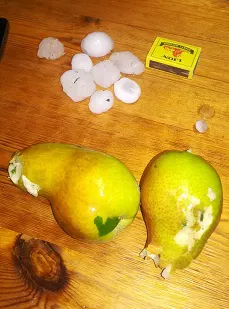 In the Koovallei, on some farms, producers didn’t mind postponing the start to the Forelle harvest last Monday due to soft rain, but that very night hail, accompanied by particularly heavy thunder, reduced the fruit in some blocks of Forelle and red apples to juice quality. Elsewhere in this late plum area, entire harvests were taken out by hail that night.
In the Koovallei, on some farms, producers didn’t mind postponing the start to the Forelle harvest last Monday due to soft rain, but that very night hail, accompanied by particularly heavy thunder, reduced the fruit in some blocks of Forelle and red apples to juice quality. Elsewhere in this late plum area, entire harvests were taken out by hail that night.
Fortunately, not many farms in the area suffered such total loss but the damage inflicted by the hail is particularly smarting, coming as it does on already reduced crops. On some cultivars there is hardly any class 1 fruit, just class 2 fruit for export.
The Forelle harvest is almost done in the Western Cape and this damage shouldn't have a major impact on Forelle supplies.
It’s been a difficult couple of years in the Klein-Karoo, which has been sharing in the Western Cape’s drought but not in the past winter’s improved rainfall, like over the Boland.
The Langeberge mountains block moisture from the southwest and where the area could expect 550mm of rainfall in a good year, the Klein-Karoo has averaged around 200mm for the past four years.
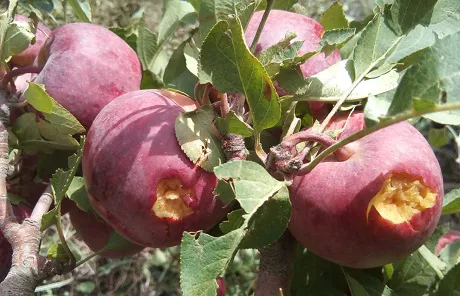 Hail damage on Early Red One in the Klein-Karoo (photos supplied by Pierre Burger)
Hail damage on Early Red One in the Klein-Karoo (photos supplied by Pierre Burger)
Some producers down to a quarter of a normal stonefruit harvest
The crop is light: reductions on yield vary from a 25% drop to an 80% drop and obtaining size, particularly on stonefruit, was a problem.
“This season cannot be seen in isolation,” says Niël Joubert of Warmwater Farm in the Worcester area. “What we’re seeing this season has been building up for the past three or four years and you could say it’s pretty disastrous. Some producers have only 25% of a normal year, while others, particularly those who are part of water schemes, are 20 or 25% down on a normal year.”
A light crop is, however, not isolated to the Klein-Karoo. Even in the Boland there are reports of plum farmers who got 5 tonnes per hectare where normally they’d take off 40.
The late plum harvest was further reduced when fruit absorbed moisture from this rain, leading to cell rupture and bursting.
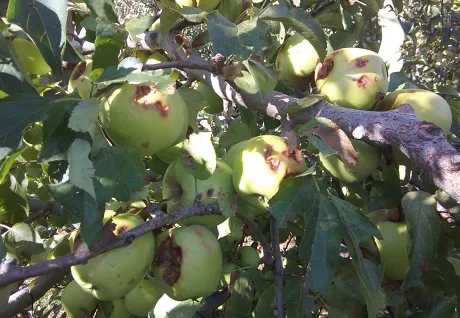
Cool spring followed by heatwave took its toll
According to Hortgro, the deciduous fruit industry body, the three month-long chilling period during the winter of 2018 was the hottest in 19 years and chilling unit accumulation, critical for fruit set, less than half the longterm average. Spring took a while to get going, remaining cool when it should’ve heated up and flowering time lingered longer than normal.
Lower chill varieties reached full bloom earlier than last season, while later flowering varieties reached full bloom up to 21 days later, only to be hit by the springtime heatwave.
Last October, as FreshPlaza reported here, the heatwave was responsible for a lot of thinning out as blossom stamens desiccated during eight consecutive days of 35°C and above (maximums reached the mid-forties).
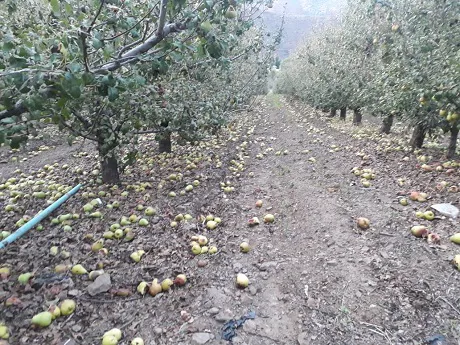 Hail damage to a Forelle orchard (photo supplied by Niël Joubert)
Hail damage to a Forelle orchard (photo supplied by Niël Joubert)
“Marketers could prepare themselves to sell 30% more plums next season”
The silver lining to last week’s hail is the soft rain that preceded it and the thunderstorm that accompanied it. Outside Montagu, stone and pomefruit farmer Pierre Burger says Proteaplaas, his farm, received 66mm in total, an amount sufficient to flush salts and moisten deeply and, particularly on trees that have now been harvested, a terrific entrance to their winter season.
For that reason, as well as the light crop giving trees some respite this year, Pierre has his hopes on a bumper crop next year.
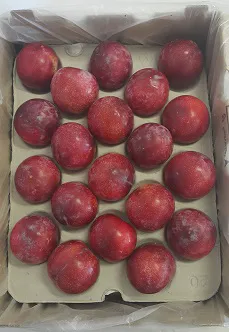 Hortgro quotes Petru du Plessis, stone fruit specialist at Bonne Esperance Farm, as saying: “This season, growers need to pay extra attention to post-harvest orchard care. Our orchards were still in rest mode after the drought, but I think the 2019/20 season could under normal circumstances deliver a 13 million carton plum harvest."
Hortgro quotes Petru du Plessis, stone fruit specialist at Bonne Esperance Farm, as saying: “This season, growers need to pay extra attention to post-harvest orchard care. Our orchards were still in rest mode after the drought, but I think the 2019/20 season could under normal circumstances deliver a 13 million carton plum harvest."
He continues: "Growers will need to seriously prune their orchards, and prepare themselves to harvest bigger crops, while marketers could prepare themselves to sell 30% more plums.”
Hortgro has named the locally developed African Delight plum the “rock star cultivar” of the past season, due to its flowering prowess during a difficult year.
